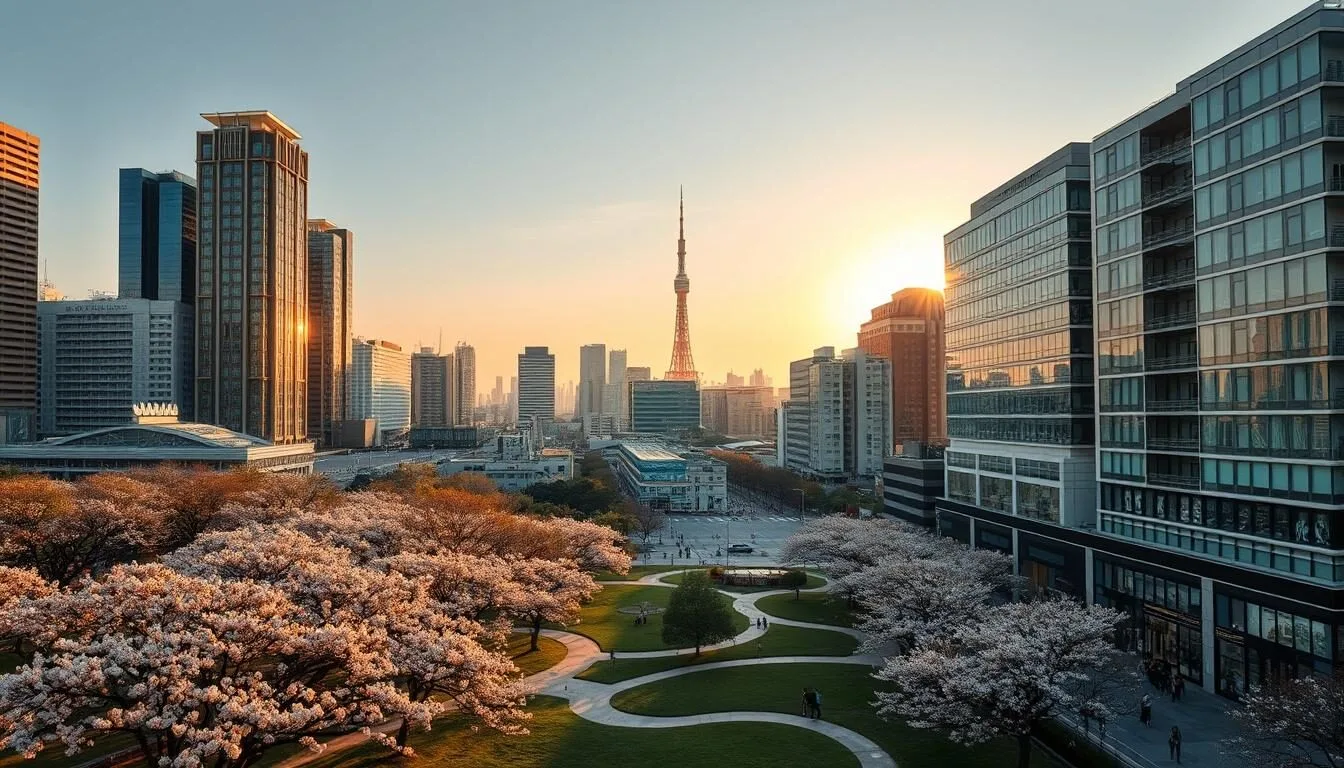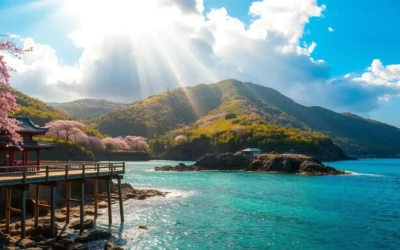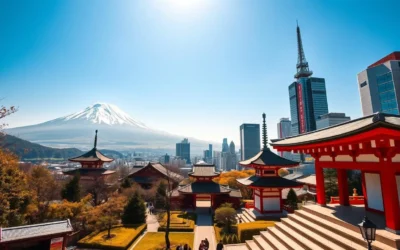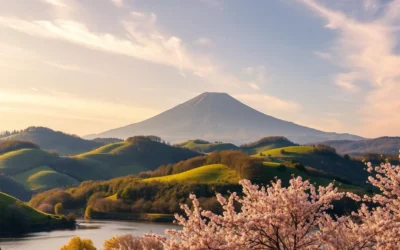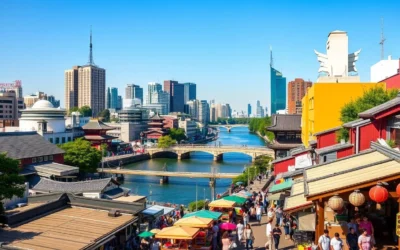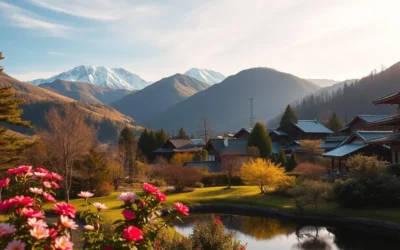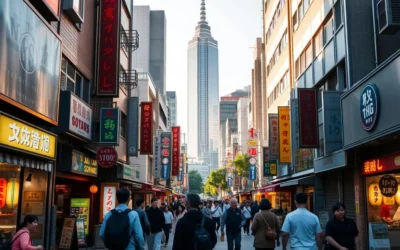Minato is a special ward in Tokyo that boasts some of Japan’s most iconic landmarks, including Roppongi Hills, Tokyo Tower, and the Azabudai Hills complex. As one of Tokyo’s most sophisticated areas, Minato is home to numerous embassies, corporate headquarters, and world-class museums.
You’ll find a perfect blend of modern and traditional experiences in Minato. From breathtaking views at towering skyscrapers to serene gardens and historic temples, this district has something for everyone. Whether you’re a first-time visitor or a seasoned traveler, Minato-ku is a must-visit destination in Tokyo.
Explore the top attractions and hidden gems in Minato, and get practical information on transportation, dining, and accommodation to make your visit memorable.
Discovering Minato-ku: Tokyo’s Sophisticated District
As you step into Minato-ku, Tokyo’s sophisticated district, you’ll uncover a blend of modern luxury and traditional charm. This district is a hub for both locals and tourists, offering a wide range of experiences that cater to different interests.
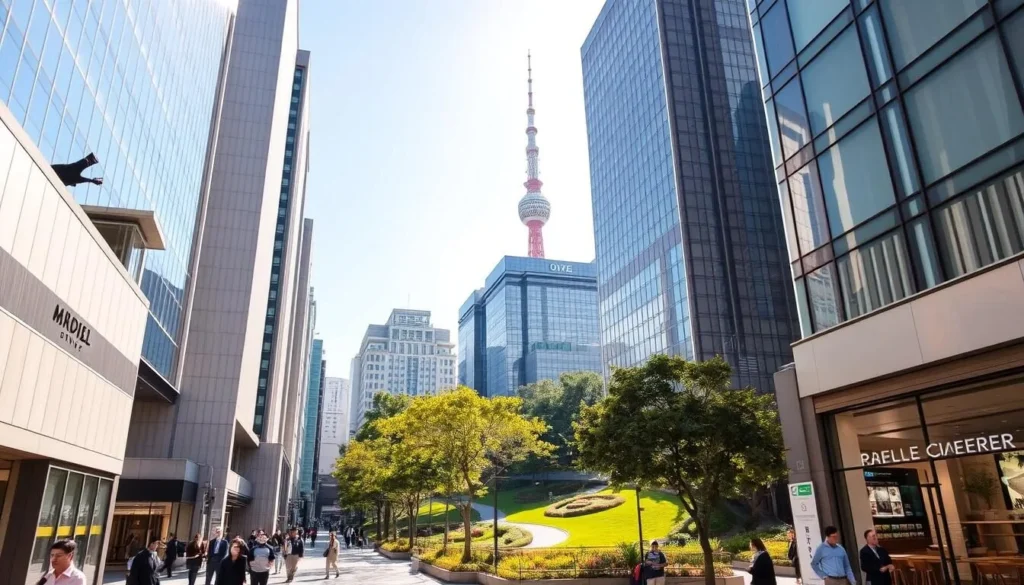
What Makes Minato-ku Special
Minato-ku stands out for its unique blend of historical landmarks and modern attractions. The district is home to iconic places like the Tokyo Tower, a symbol of Japan’s post-war rebirth, and Roppongi Hills, a complex that embodies the modern Tokyo spirit.
One of the key aspects that make Minato-ku special is its ability to seamlessly blend tradition with modernity. For instance, you can visit the Zojoji Temple, a historic Jodo-shu Buddhist temple, and then explore the contemporary art scene at the Mori Art Museum.
| Attraction | Location | Metro Line |
|---|---|---|
| Roppongi Hills | Roppongi | Hibiya Metro Line to Roppongi Station |
| Azabudai Hills | Azabu-Juban | Hibiya Metro Line to Kamiyacho Station |
| Tokyo Tower | Shiba-koen | Mita Metro Line to Onarimon Station |
A Brief History of Minato-ku
Minato-ku has a rich history that dates back to the Edo period. The district has evolved significantly over the years, transforming from a primarily residential area to a bustling hub of commerce and entertainment.
Historically, Minato-ku was known for its role in Japan’s maritime trade. The district’s proximity to the sea made it an ideal location for ports and trading houses. Today, remnants of this history can still be seen in its architecture and cultural landmarks.
Planning Your Visit to Minato-ku
To make the most of your trip to Minato-ku, it’s essential to plan your itinerary. You’ll want to dedicate at least one full day to explore the district’s highlights, though two days would allow for a more relaxed pace.
- Plan your visit according to the seasons: spring (March-May) for cherry blossoms and autumn (October-November) for colorful foliage.
- Organize your itinerary by area to maximize your time and reduce travel between attractions.
- Utilize Tokyo’s efficient subway system, with key stations including Roppongi, Azabu-Juban, and Kamiyacho.
- Consider purchasing a day pass for Tokyo’s metro system to visit multiple attractions across Minato-ku in a single day.
When visiting Minato-ku, you’ll have the opportunity to see iconic landmarks like the Tower and experience a variety of things to do, from shopping at Roppongi Hills to exploring the historic Zojoji Temple. This place is truly a gem in Tokyo, offering something for everyone.
Tokyo Tower: The Iconic Landmark of Minato
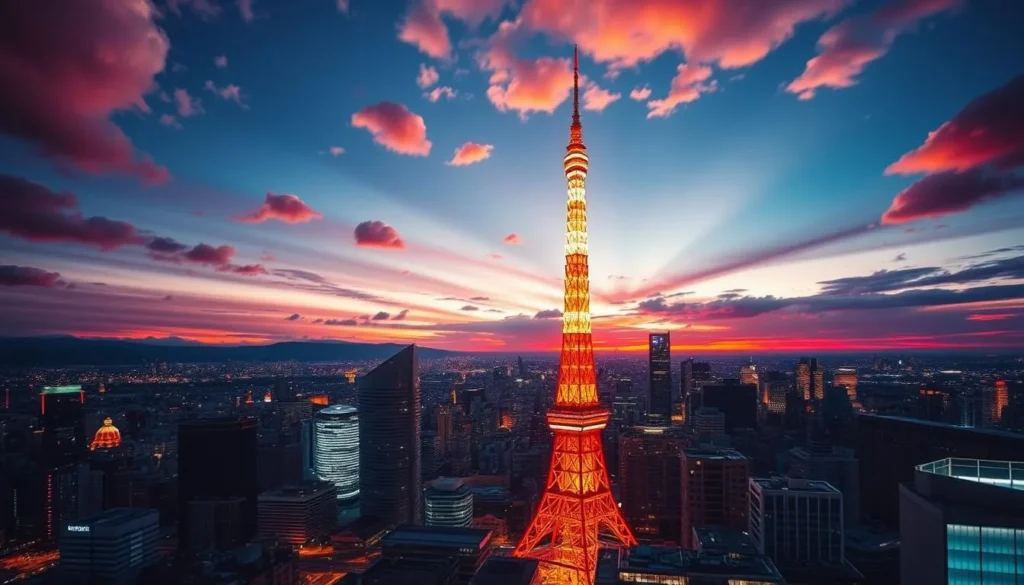
In the heart of Minato-ku lies Tokyo Tower, an engineering marvel that has become synonymous with Tokyo’s skyline. This iconic landmark has been a part of Tokyo’s identity since its construction and continues to attract visitors from around the world.
History and Significance of Tokyo Tower
Tokyo Tower was built in 1958, inspired by the Eiffel Tower in Paris. It was constructed as a symbol of Japan’s rebirth and economic growth following World War II. At the time of its completion, it was the tallest tower in the world, standing at 333 meters tall. The tower’s design is a testament to Japanese engineering and its ability to blend traditional aesthetics with modern technology.
The significance of Tokyo Tower extends beyond its height; it has become a cultural icon and a symbol of Tokyo’s ever-evolving landscape. Over the years, it has witnessed the city’s transformation and has been a constant presence in the lives of Tokyo’s residents and visitors.
Main Deck and Top Deck Experiences
Visiting Tokyo Tower offers an unforgettable experience, especially when you ascend to its observation decks. The Main Deck, located at 150 meters, provides panoramic views of the city and is equipped with telescopes for a closer look at Tokyo’s landmarks. You can also enjoy the glass floor for a thrilling view straight down to the ground.
The Top Deck, situated at 250 meters, offers an even more breathtaking perspective of Tokyo. On a clear day, you can see as far as Mount Fuji, providing a truly unforgettable experience. The Top Deck is also a great spot to watch the sunset, as the city transitions from day to night.
Practical Information: Hours, Tickets, and Tips
Tokyo Tower is open daily from 9:00 AM to 10:30 PM, with the last admission at 9:30 PM. When planning your visit, you have two ticket options: a ticket for the Main Deck only, priced at 1,200 yen, or a combined ticket for both the Main Deck and Top Deck, available for 2,800 yen when purchased in advance.
It’s highly recommended to purchase tickets online in advance, especially during peak tourist seasons, to avoid long waiting times. For the best experience, consider visiting during sunset to witness the city transition from day to night. After enjoying the observation decks, explore the tower’s lower levels, which house various shops, restaurants, and attractions like the One Piece Tower, a theme park based on the popular anime.
Roppongi Hills: A City Within a City
Roppongi Hills is more than just a shopping mall; it’s a city within a city that offers a diverse range of activities and experiences. As you step into this vibrant complex, you’ll be greeted by a world of luxury, entertainment, and culture.
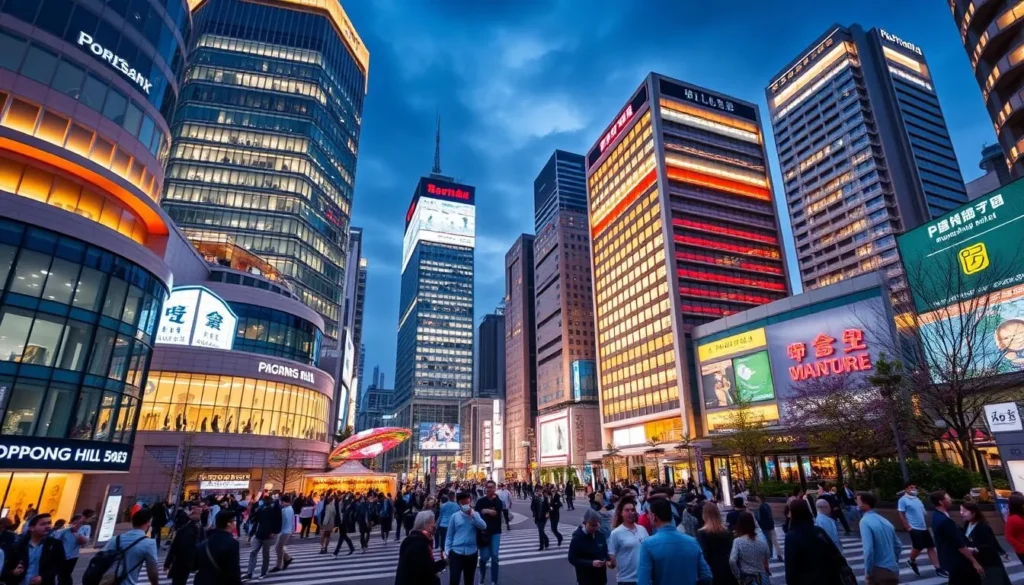
Exploring the Roppongi Hills Complex
The Roppongi Hills complex is a marvel of modern architecture, with a mix of office spaces, residential areas, and entertainment facilities. As you explore the complex, you’ll discover a range of attractions, including the Mori Tower, which offers panoramic views of Tokyo from its observation decks.
The complex is designed to be easily navigable, with clear signage and accessible pathways. You can spend hours exploring the various facilities, from shopping malls to art galleries, and enjoying the various amenities on offer.
Open-Air Sculptures and Public Art
One of the unique features of Roppongi Hills is its open-air sculptures and public art installations. The complex features a range of contemporary art pieces, from large-scale sculptures to interactive installations, which add to the overall aesthetic appeal of the area.
As you stroll through the complex, you’ll come across various art pieces that showcase the work of local and international artists. These installations not only add to the beauty of the complex but also provide a unique cultural experience.
Shopping and Dining at Roppongi Hills
Roppongi Hills is renowned for its shopping and dining experiences. The complex is home to over 200 shops and restaurants, ranging from international luxury brands to unique Japanese boutiques.
You can indulge in a range of culinary delights, from casual eateries to fine dining establishments, many of which offer spectacular views of the Tokyo skyline. Be sure to try some of the recommended restaurants, such as Gyopao Gyoza Roppongi for delicious gyozas, Burger Revolution Tokyo for gourmet Wagyu beef burgers, or Akabekoya for mouthwatering yakiniku.
The shopping and dining areas are thoughtfully designed, with rest areas, viewing spots, and seasonal decorations that enhance the overall experience.
Mori Art Museum and Tokyo City View
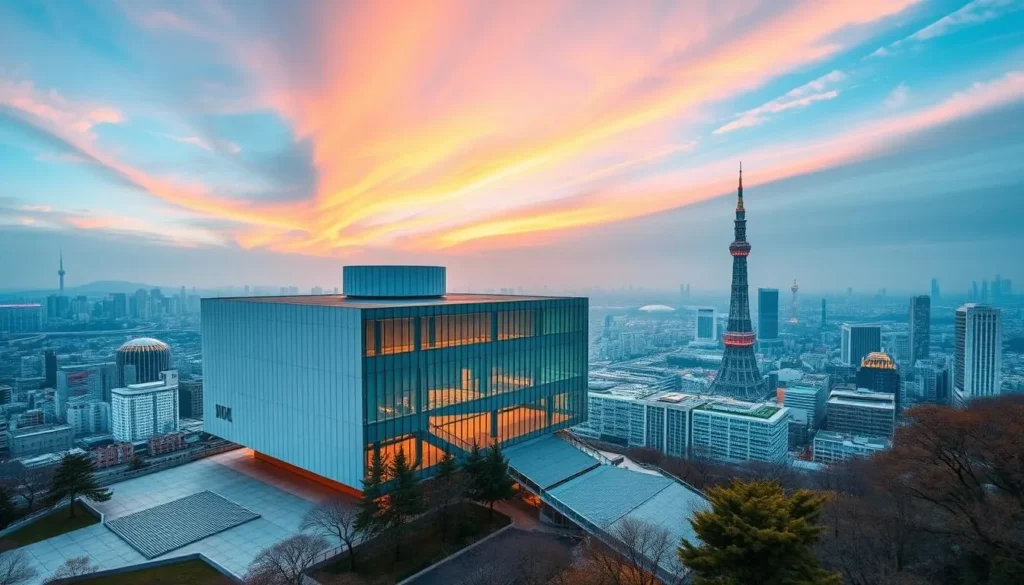
For those seeking a blend of culture and breathtaking vistas, the Mori Art Museum and Tokyo City View are must-visit destinations in Minato-ku, Tokyo. These attractions, located within the Roppongi Hills complex, offer a unique experience that combines contemporary art with panoramic views of the city.
Contemporary Art at Mori Art Museum
The Mori Art Museum is renowned for its collection of contemporary art from around the world. As you explore the museum, you’ll encounter a diverse range of works, from paintings and sculptures to installations and multimedia exhibits. The museum’s focus on innovation and creativity makes it a fascinating destination for art lovers. The current exhibitions feature a mix of established and emerging artists, ensuring a fresh and engaging experience with each visit.
One of the highlights of the Mori Art Museum is its ability to bring together artists and ideas from different parts of the globe. This international perspective is reflected in the museum’s exhibitions, which often explore themes relevant to contemporary society. By engaging with the art on display, visitors can gain a deeper understanding of the global art scene and its trends.
Breathtaking Views from Tokyo City View
Located on the 52nd floor of the Mori Tower, Tokyo City View offers an unparalleled observation deck experience. As you gaze out from the viewing platform, you’ll be treated to stunning vistas of Tokyo’s sprawling cityscape. On a clear day, you can see iconic landmarks like Tokyo Tower and Mount Fuji, providing a unique perspective on the city’s layout and geography.
The observation deck is open daily from 10:00 AM to 10:00 PM, with last entry at 9:30 PM. Visitors can purchase tickets online for 2,000 yen, which is a discount from the onsite price of 2,200 yen. For the best experience, plan your visit for late afternoon to witness both the daytime views and the spectacular night cityscape after sunset.
Visitor Information and Best Times to Visit
When planning your visit to the Mori Art Museum and Tokyo City View, there are several factors to consider. Firstly, it’s worth noting that a single ticket grants access to both attractions, making it an excellent value. The complex is open daily, and weekday mornings tend to be less crowded, making them an ideal time to visit if you prefer a more relaxed experience.
- Tokyo City View welcomes visitors daily from 10:00 AM to 10:00 PM, with last entry permitted at 9:30 PM.
- You can purchase tickets online for 2,000 yen (a 200 yen discount from the onsite price of 2,200 yen).
- For the best experience, plan your visit for late afternoon so you can witness both daytime views and the spectacular night cityscape after sunset.
- Weekday mornings typically offer the least crowded experience, while weekends and holidays can be considerably busier.
- Your Tokyo City View ticket also includes admission to the Mori Art Museum, making it an excellent value for experiencing both art and panoramic views.
Always check the official website for the latest information on opening hours and ticket prices to ensure a smooth visit.
Zojoji Temple: Tradition Meets Modernity
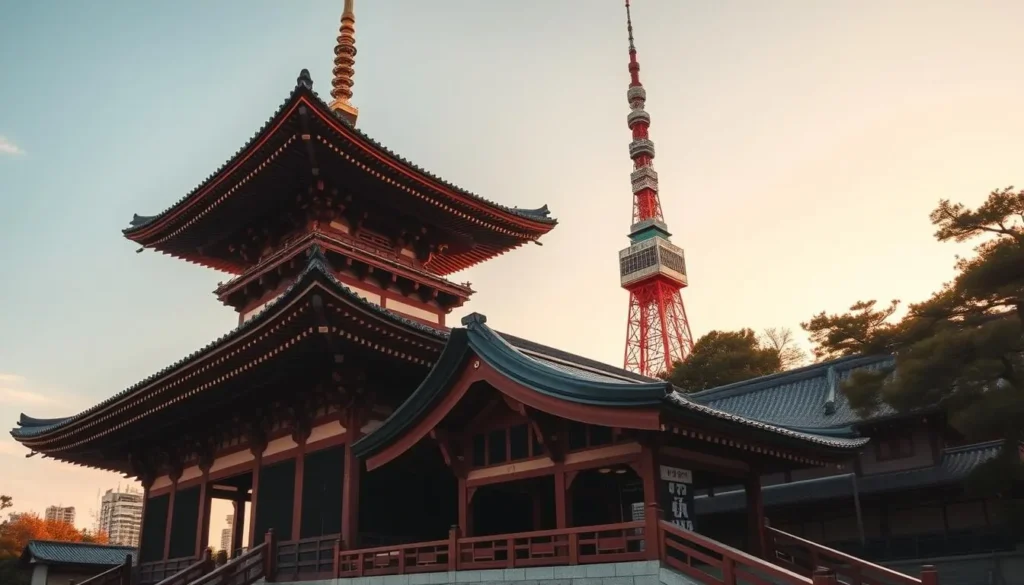
In the heart of Tokyo’s Minato-ku district lies the historic Zojoji Temple, a place where tradition and modernity blend seamlessly. This iconic temple, with its rich history and cultural significance, offers visitors a unique glimpse into Japan’s heritage.
The Historical Significance of Zojoji
Zojoji Temple, a major Jodo-shu Buddhist temple, has been a cornerstone of Japanese culture since its establishment in 1393. The temple’s historical significance is deeply rooted in its association with the Tokugawa shoguns, who ruled Japan from the 17th to the 19th century. The temple served as the family temple of the Tokugawa family, and many of its members are buried in the temple grounds.
The temple’s main hall, rebuilt in 1974, is an impressive structure that houses a revered image of Amida Buddha. Visitors can explore the temple grounds, which include various important cultural assets such as the Zojoji Temple Bell, a designated Important Cultural Property.
Exploring the Temple Grounds and Buildings
As you explore the temple grounds, you’ll discover a serene oasis in the midst of bustling Tokyo. The temple’s main hall is an architectural marvel, with its traditional design and beautiful gardens. The tranquil atmosphere provides a perfect respite from the city’s hustle and bustle.
Visitors can also explore the surrounding area, which includes a museum and various cultural exhibits. The temple grounds are particularly beautiful during cherry blossom season, making it a popular spot for hanami (cherry blossom viewing).
The Perfect Photo Spot: Tokyo Tower Behind Zojoji
One of the most iconic views in Tokyo is the juxtaposition of the ancient Zojoji Temple with the modern Tokyo Tower in the background. This unique visual representation symbolizes Japan’s harmonious blend of ancient traditions and cutting-edge modernity.
The best photo spot is just inside the temple’s main gate, where you can capture both the traditional temple architecture and the soaring Tokyo Tower in a single frame. The scene is particularly stunning at sunset when the temple is bathed in golden light and Tokyo Tower begins to illuminate against the darkening sky.
During cherry blossom season, this photo spot becomes even more magical with pink blossoms framing the temple and tower, creating a truly unforgettable image.
Azabudai Hills: Tokyo’s Newest Landmark
Experience the future of urban living at Azabudai Hills, Tokyo’s latest iconic destination. This complex is a marvel of modern architecture, offering a blend of luxury, innovation, and breathtaking views of the city.
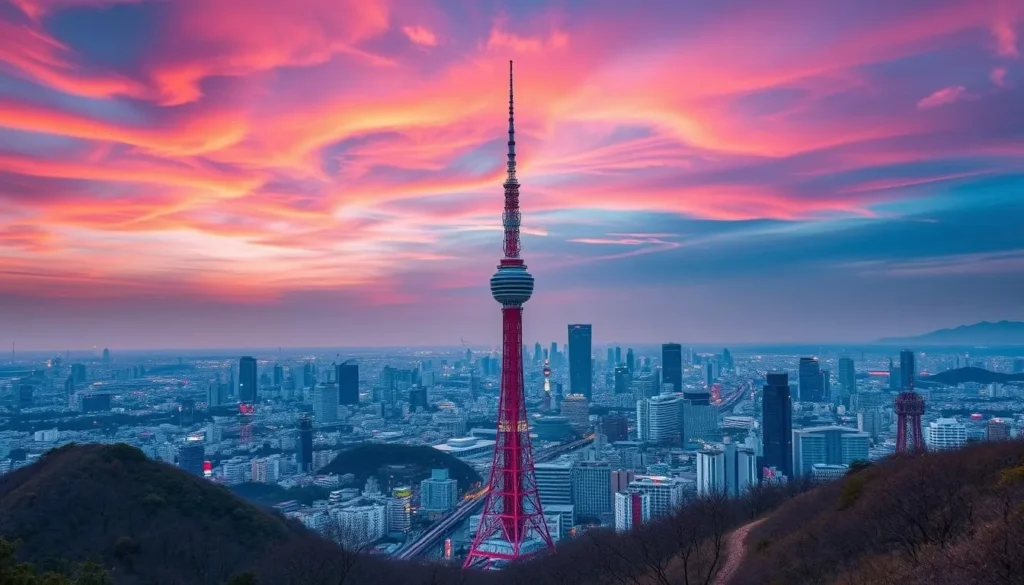
The Impressive Mori JP Tower
The Mori JP Tower is the centerpiece of Azabudai Hills, standing tall as a testament to modern engineering. This building is not just a feat of architecture; it’s a hub for business, luxury, and entertainment.
As you ascend to the higher floors, you’ll be treated to panoramic views of Tokyo, a sight that is both mesmerizing and humbling.
The tower’s design is a blend of functionality and aesthetics, making it a standout in Tokyo’s skyline.
Shopping and Dining at Azabudai Hills
Azabudai Hills offers an unparalleled shopping and dining experience. From high-end boutiques to unique local shops, you’ll find something that suits your taste. The complex is designed to provide a seamless and enjoyable experience, with amenities and services that cater to your every need.
When it comes to dining, you’ll have a variety of options to choose from, ranging from fine dining restaurants to casual eateries. Whether you’re looking for a quick bite or a luxurious meal, Azabudai Hills has you covered.
Sky Lobby and Observation Points
The Sky Lobby on the 33rd floor of Mori JP Tower is a highlight of Azabudai Hills, offering breathtaking views of Tokyo. Although access is restricted to residents, workers, and guests with reservations at Dining33 or the Sky Room café, it’s an experience worth noting.
From the Sky Lobby, you’ll get a unique perspective of Tokyo, with the iconic Tokyo Tower being a particularly close-up sight. The observation areas feature floor-to-ceiling windows, providing unobstructed views and excellent photo opportunities.
If you’re unable to access the Sky Lobby, consider making a reservation at one of the high-floor restaurants or cafés that offer similar observation experiences.
TeamLab Borderless: Digital Art Experience

Immerse yourself in the enchanting universe of TeamLab Borderless, a place where art and technology converge. Located in the heart of Tokyo, this digital museum is a must-visit destination for anyone fascinated by innovative art experiences.
What to Expect at TeamLab Borderless
As you enter TeamLab Borderless, you’ll be transported into a world of mesmerizing digital displays and interactive installations. The museum is designed to be explored freely, allowing you to wander through its vast spaces and discover new wonders at every turn. With no fixed path, you’re encouraged to let your curiosity guide you through the various exhibits.
The installations at TeamLab Borderless are not just visually stunning; they often invite interaction, making the experience highly immersive. You can expect to see a variety of digital art forms, from projections that transform the environment around you to interactive displays that respond to your movements.
Most Popular Installations and Exhibits
Some of the most popular installations include the Forest of Flowers and People, where digital flowers bloom and wither in response to visitor movements, and the Lamp Garden, a serene environment filled with lamps that change color and pattern. Each exhibit is a unique blend of technology and creativity, ensuring that every visit to TeamLab Borderless offers something new to discover.
Other notable exhibits include the Borderless World, where digital art knows no boundaries, and Future Park, an area designed for children to engage with interactive digital installations. These exhibits showcase the innovative spirit of TeamLab Borderless, making it a fascinating place to explore.
Tickets, Timing, and Photography Tips
To visit TeamLab Borderless, it’s essential to purchase tickets in advance through their official website, as the attraction frequently sells out, especially on weekends and holidays. Ticket prices vary depending on the day and season, so it’s a good idea to check the official website for the most up-to-date pricing.
Plan to spend at least 2-3 hours exploring the museum to fully experience all the installations. For the best photography results, wear solid colors, especially white, as they interact better with the projections and light installations. While photography is encouraged, note that tripods and professional equipment are not permitted, so be prepared to capture memories with handheld devices.
TeamLab Borderless operates daily from 9:00 AM to 9:00 PM. Planning your visit during less crowded times can enhance your experience, allowing you to enjoy the exhibits without the rush.
Shiba Park: Urban Greenery with a View
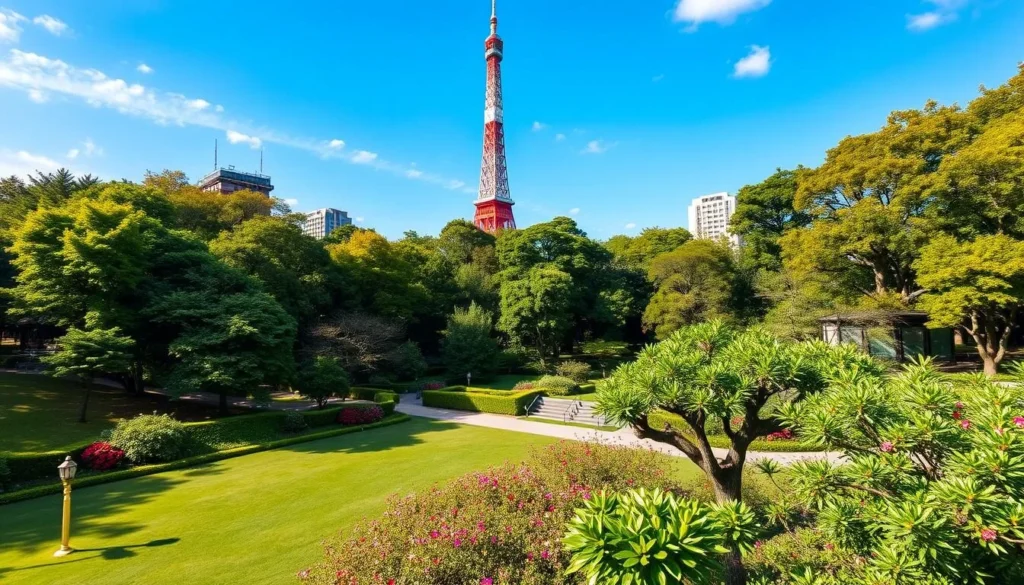
As one of Tokyo’s oldest public parks, Shiba Park provides a unique blend of natural beauty and urban landscape. You can enjoy a peaceful stroll through the park’s lush greenery, explore its historical significance, and take in the stunning views of Tokyo Tower.
Exploring Tokyo’s Oldest Public Park
Shiba Park, located in the heart of Minato-ku, is a historic place that has been a part of Tokyo’s landscape for centuries. As you walk through the park, you’ll discover its tranquil atmosphere, beautiful garden designs, and the various flora that change with the seasons. The park is particularly famous for its cherry blossom displays in the spring, attracting visitors from all over the world for hanami (cherry blossom viewing) parties.
The park’s design incorporates traditional Japanese landscaping, with carefully manicured trees and shrubs, creating a serene garden environment. You can take a leisurely walk along the park’s paths, enjoy the scenic views, and appreciate the beauty of nature in the midst of the bustling city.
Perfect Sunset Spots with Tokyo Tower Views
One of the highlights of visiting Shiba Park is witnessing the sunset with Tokyo Tower as the backdrop. The park offers several vantage points where you can watch the sun dip below the horizon, casting a warm glow over the city. It’s a perfect spot to relax and enjoy the view, making for a memorable experience during your days in Tokyo.
As the sun sets, the atmosphere in the park becomes even more magical, with the illuminated Tokyo Tower standing tall against the night sky. You can capture stunning photographs, enjoy a picnic, or simply bask in the beauty of the moment.
Seasonal Highlights and Events
Shiba Park is a park that transforms with the seasons, offering something unique and beautiful throughout the year. In the spring, the park is renowned for its spectacular cherry blossom displays, typically from late March to early April. Summer brings lush greenery and occasional outdoor events, providing shade from Tokyo’s summer heat.
Autumn is another highlight, with the park’s maple and ginkgo trees turning brilliant shades of red, orange, and gold in November. Winter brings a different charm, with illumination events and the unique beauty of Tokyo Tower rising above the bare trees against clear winter skies. The park hosts various seasonal events throughout the year, including cultural performances, food festivals, and traditional Japanese celebrations, making it a vibrant place to visit at any time.
The National Art Center: A Cultural Haven
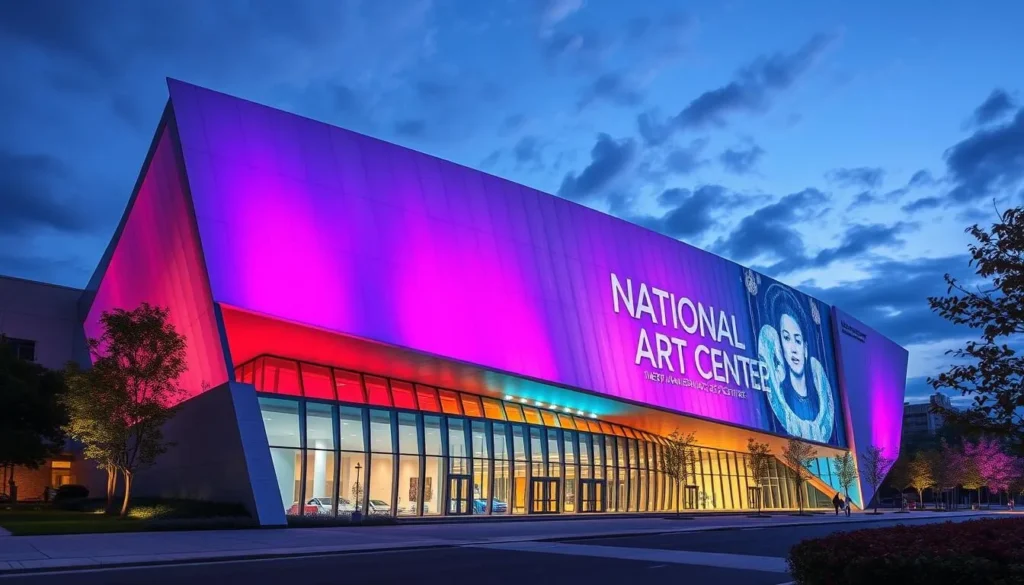
The National Art Center in Tokyo is a cultural gem that offers a diverse range of artistic experiences. As you visit this prominent institution, you are immersed in a world of contemporary and modern art.
Architecture and Design of the Center
The National Art Center’s building is a masterpiece of modern architecture, with a design that emphasizes natural light and open spaces. The impressive façade and the airy atrium create a welcoming atmosphere for visitors. As you explore the center, you’ll notice the thoughtful use of space, which facilitates a smooth flow of visitors through the various exhibition areas.
The center’s design also incorporates sustainable elements, reflecting its commitment to environmental responsibility. The building’s architecture has been praised for its innovative use of materials and its ability to blend into the surrounding landscape while standing out as a unique cultural landmark.
Rotating Exhibitions and Permanent Collections
The National Art Center is renowned for its dynamic exhibitions, which change throughout the year. You can expect to find a wide range of artistic expressions, from traditional Japanese art to cutting-edge contemporary installations. The center’s rotating exhibitions ensure that there’s always something new to discover, making it a fascinating place to visit multiple times.
In addition to its temporary exhibitions, the center also houses a collection of artworks that are showcased in its permanent galleries. These collections provide insight into the rich cultural heritage of Japan and the evolution of its art over the years. As you explore the galleries, you’ll have the opportunity to see works by both established and emerging artists.
Visitor Information and Nearby Attractions
To plan your visit to The National Art Center, it’s helpful to know that it is open from 10:00 AM to 6:00 PM, with extended hours until 8:00 PM on Fridays. The center is closed on Tuesdays unless a national holiday falls on that day. Admission prices vary depending on the exhibitions, with some special exhibitions requiring separate tickets.
The National Art Center is conveniently located in Roppongi, making it easy to combine your visit with other cultural attractions in the area. You can also explore nearby attractions like the Mori Art Museum and 21_21 Design Sight. To get to the center, you can take the Chiyoda Line to Nogizaka Station or the Hibiya and Oedo Lines to Roppongi Station, both of which offer a short walk to the center.
The center also features excellent facilities, including a café with views of the atrium, a restaurant, museum shops, and a comprehensive art library. Whether you’re looking to relax, dine, or learn more about art, The National Art Center provides a comprehensive and enriching experience.
Tokyo Midtown: Shopping, Art, and Entertainment
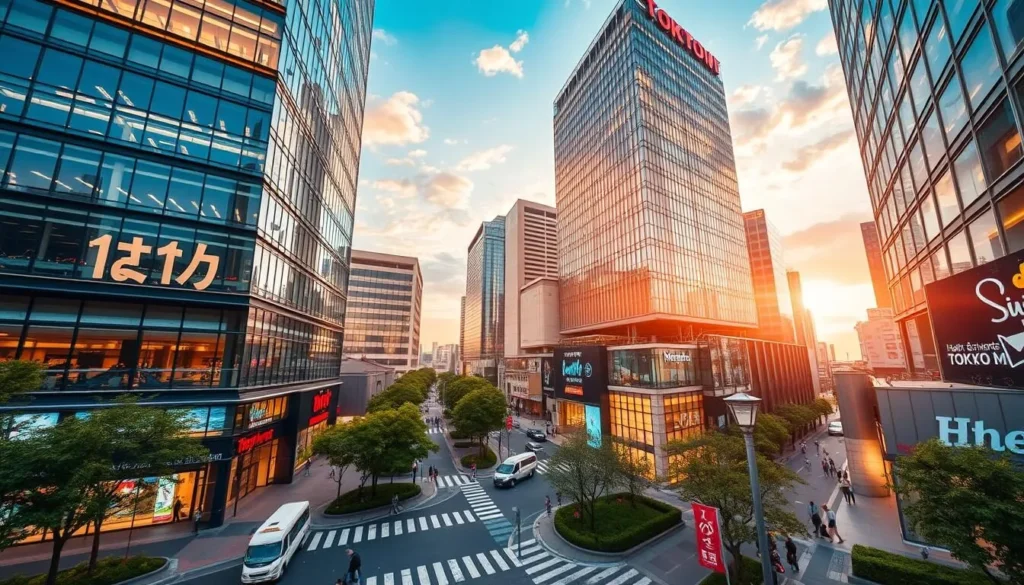
As one of Tokyo’s most dynamic areas, Tokyo Midtown combines upscale shopping, world-class art, and exciting entertainment options. This complex has become a must-visit destination for anyone looking to experience the best of what Tokyo has to offer.
Exploring the Tokyo Midtown Complex
Tokyo Midtown is more than just a shopping center; it’s an integrated complex that offers a wide range of activities and experiences. The complex is home to numerous high-end retail stores, art galleries, and entertainment facilities, making it a perfect spot for a day out with family or friends.
The complex’s design emphasizes a seamless blend of indoor and outdoor spaces, with the beautiful Midtown Garden providing a serene escape from the bustling city. Visitors can enjoy a leisurely stroll through the garden, which features a variety of plant species and themed areas.
Suntory Museum of Art and 21_21 Design Sight
Art enthusiasts will find Tokyo Midtown to be a treasure trove, with the Suntory Museum of Art being a highlight. The museum showcases a diverse collection of Japanese and Asian art, with a focus on the Suntory collection, which includes ancient artifacts and contemporary pieces.
Adjacent to the Suntory Museum of Art is 21_21 Design Sight, a unique design gallery that features innovative and thought-provoking exhibitions. The gallery’s design itself is worth experiencing, with its sleek and modern architecture.
Midtown Garden and Seasonal Events
The Midtown Garden is a standout feature of the Tokyo Midtown complex, spanning approximately 40,000 square meters. This expansive green space is not just a pretty face; it’s a vibrant hub of activity throughout the year, with various seasonal events and plantings.
Visitors can explore different themed areas within the garden, including the Hinokicho Park, which is a preserved portion of a historic garden. The garden is particularly famous for its 140 cherry trees, which create a breathtaking spectacle during spring.
Summer brings the “Midtown Loves Summer” event, complete with outdoor terraces, misting stations, and enchanting nighttime illuminations. In winter, the “Midtown Christmas” celebration draws visitors with its stunning illuminations and outdoor ice skating rink.
Throughout the year, the Midtown Garden transforms to reflect the changing seasons, ensuring that there’s always something new to discover. Whether you’re a nature lover, a photography enthusiast, or simply looking for a peaceful retreat, the Midtown Garden is a must-visit.
Hamarikyu Gardens: A Peaceful Oasis
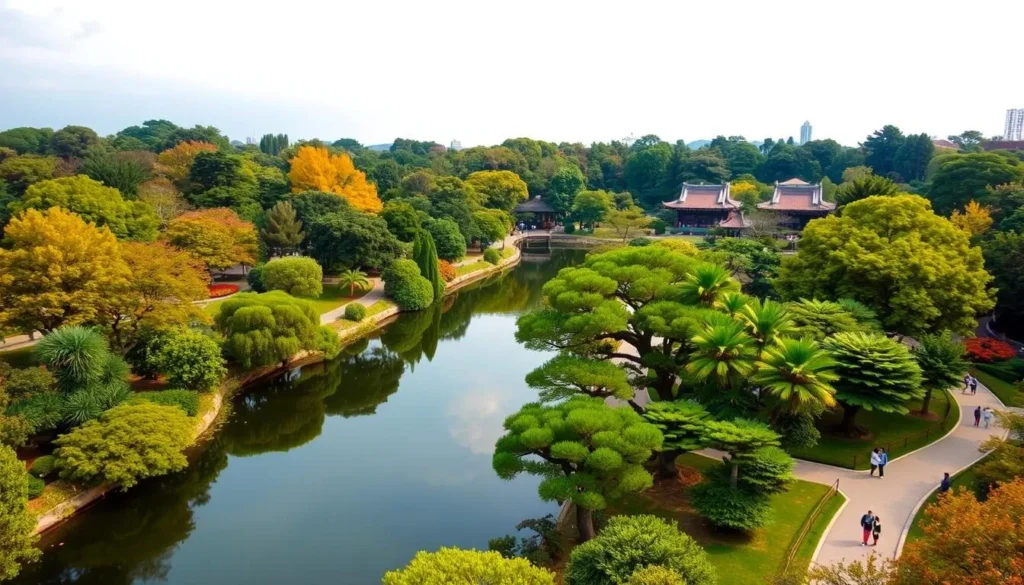
Hamarikyu Gardens is a hidden gem in Minato-ku, providing a peaceful escape from the urban jungle. This former duck hunting ground for the Imperial family is now a popular destination for those seeking serenity in the heart of Tokyo.
History and Design of the Gardens
Hamarikyu Gardens boasts a rich history dating back to the Edo period. The garden was originally a part of a larger hunting ground for the Tokugawa shoguns, and its design reflects the traditional Japanese landscaping techniques, incorporating ponds, walking paths, and teahouses. The garden’s unique design includes a seawater pond, a reminder of its past as a tidal flat, which adds to its charm and historical significance.
The garden is a place where nature and history blend seamlessly, offering visitors a chance to experience the tranquility of a traditional Japanese garden in the midst of the bustling city of Tokyo.
Tea House Experience and Seasonal Highlights
One of the highlights of visiting Hamarikyu Gardens is the tea house experience. The Nakiri-tei teahouse, located on the edge of the pond, offers traditional Japanese tea ceremonies, providing a serene and authentic experience. Visitors can enjoy the beautiful garden views while sipping on matcha.
The garden is also renowned for its seasonal highlights. In the spring, the plum blossoms attract many visitors, while the autumn foliage is equally breathtaking. The changing seasons bring a new layer of beauty to the garden, making it a garden worth visiting multiple times throughout the year.
Practical Information for Visitors
For those planning to visit Hamarikyu Gardens, here are some practical details. The garden is open from 9:00 AM to 5:00 PM, with the last entry at 4:30 PM. It is closed from December 29 to January 1 for the New Year holiday. The entrance fee is very reasonable at 300 yen for adults, with free admission for seniors over 65 and children under 12.
Visitors can access the garden by land via Shiodome or Tsukijishijo Stations, or by water via the Tokyo Cruise Ship water bus terminal within the garden. Arriving by water bus from Asakusa offers a unique perspective of Tokyo and allows visitors to appreciate the garden’s historical role as a waterfront property, with views of Tokyo’s waterfront and the distant tower of Tokyo.
Audio guides are available in multiple languages to enhance your understanding of the garden’s historical and cultural significance, making it a more enjoyable and informative visit.
Nezu Museum: Ancient Art in a Modern Setting
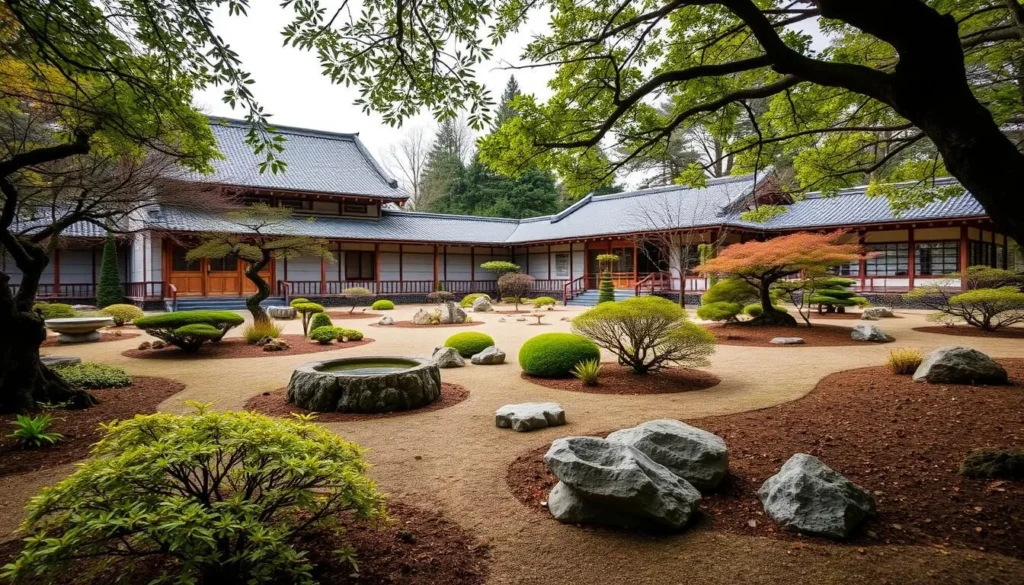
As you step into the Nezu Museum, you’re surrounded by a rich collection of Asian art and antiquities. Located in the heart of Tokyo’s upscale Aoyama neighborhood, this museum is a haven for those interested in exploring the depths of ancient cultures.
The Museum’s Impressive Collection
The Nezu Museum boasts an extensive collection of Asian art, including Chinese, Japanese, and Korean pieces. With over 7,000 items, the museum’s holdings span from ancient ceramics and sculptures to calligraphy and paintings. You can explore the evolution of East Asian art through the ages, gaining insights into the cultural and historical contexts that shaped these works.
Some of the highlights include rare Chinese bronzes, Japanese ukiyo-e prints, and Korean ceramics. The museum regularly updates its exhibitions, so you can discover new pieces each time you visit.
The Beautiful Japanese Garden
One of the Nezu Museum’s most striking features is its tranquil Japanese garden. Designed in the traditional style, the garden is a perfect blend of natural beauty and meticulous landscaping. As you stroll through the garden, you’ll notice the carefully placed stones, the vibrant flora, and the serene water features, all of which create a peaceful ambiance.
The garden is particularly beautiful during the changing seasons. In the spring, cherry blossoms bloom, while autumn brings a kaleidoscope of colors as the leaves change. The museum’s café, overlooking the garden, offers a perfect spot to relax and enjoy Japanese-inspired refreshments after viewing the exhibitions.
Visitor Information and Nearby Attractions
The Nezu Museum is open from 10:00 AM to 5:00 PM, with the last entry at 4:30 PM. It is closed on Mondays unless a national holiday falls on that day. The admission fee varies depending on special exhibitions, typically ranging from 1,100 to 1,300 yen for adults.
Located in the fashionable Aoyama district, the museum is easily accessible and is within walking distance of several other attractions. You can explore Omotesando Avenue, known as Tokyo’s “Champs-Élysées,” visit the Prada Building designed by Herzog & de Meuron, or browse through numerous art galleries in the area.
Culinary Delights in Minato-ku
Your culinary journey in Tokyo is not complete without visiting Minato-ku, where you’ll discover a world of flavors. Minato offers diverse culinary experiences, from high-end sushi restaurants to casual ramen shops and everything in between.
Top Restaurants in Roppongi
Roppongi is known for its vibrant dining scene, offering a range of options to suit every palate. Whether you’re in the mood for sushi, Italian, or Asian fusion, Roppongi has something for everyone. Some top recommendations include dining at one of the many restaurants in Roppongi Hills, where you can enjoy not only excellent cuisine but also spectacular views of the city. It’s a perfect place to enjoy a meal while taking in the sights.
For a truly memorable dining experience, consider visiting one of the high-end sushi restaurants. These establishments offer a unique and refined culinary experience, with a focus on fresh, high-quality ingredients. For a more casual meal, Roppongi is also home to a variety of ramen shops and other eateries serving delicious, comforting food.
Hidden Gems in Azabudai and Shimbashi
Beyond Roppongi, Minato-ku is home to other culinary hotspots, including Azabudai and Shimbashi. These areas offer a mix of traditional and modern dining experiences, from classic Japanese cuisine to innovative, contemporary restaurants. You can plan your trips to these areas to explore the various dining options.
One of the hidden gems in this area is the conveyor belt sushi restaurants. Minato has several quality options that offer fresh fish at reasonable prices, making it a great place to try this popular Japanese dining experience. Additionally, the basement food halls (depachika) in nearby department stores are worth exploring, offering a wide variety of Japanese and international delicacies.
Food Experiences Not to Miss
When visiting Minato-ku, there are several food experiences that you shouldn’t miss. First, be sure to try a traditional Japanese tea ceremony, available at various tea houses, including the one in Hamarikyu Gardens. This serene and culturally rich experience is a perfect complement to your culinary adventures.
For a special occasion, consider dining at one of the restaurants in Tokyo Tower or Roppongi Hills, where culinary excellence is paired with spectacular views. You should also consider joining a food tour of specific neighborhoods in Minato-ku, which provide guided culinary adventures with expert insights into Japanese food culture and history.
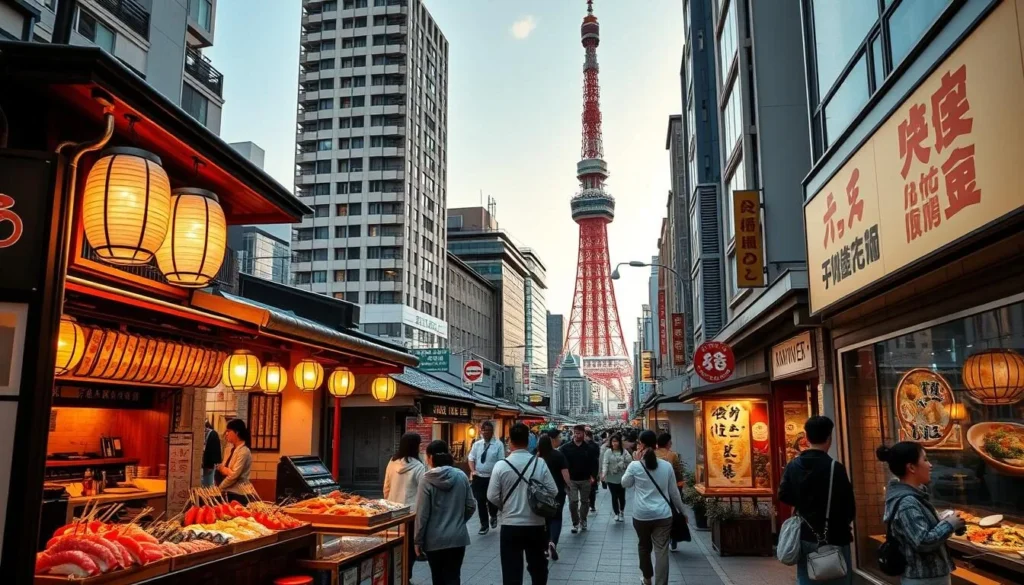
| Location | Dining Experience | Price Range |
|---|---|---|
| Roppongi | High-end Sushi | $$$ |
| Azabudai | Conveyor Belt Sushi | $$ |
| Hamarikyu Gardens | Traditional Japanese Tea Ceremony | $ |
| Roppongi Hills | Dining with a View | $$$ |
Where to Stay in Minato-ku
Minato-ku, a hub of cultural, business, and entertainment activities in Tokyo, provides travelers with a variety of places to stay, from luxury hotels to budget-friendly options. When visiting this vibrant district, choosing the right accommodation can significantly enhance your experience.
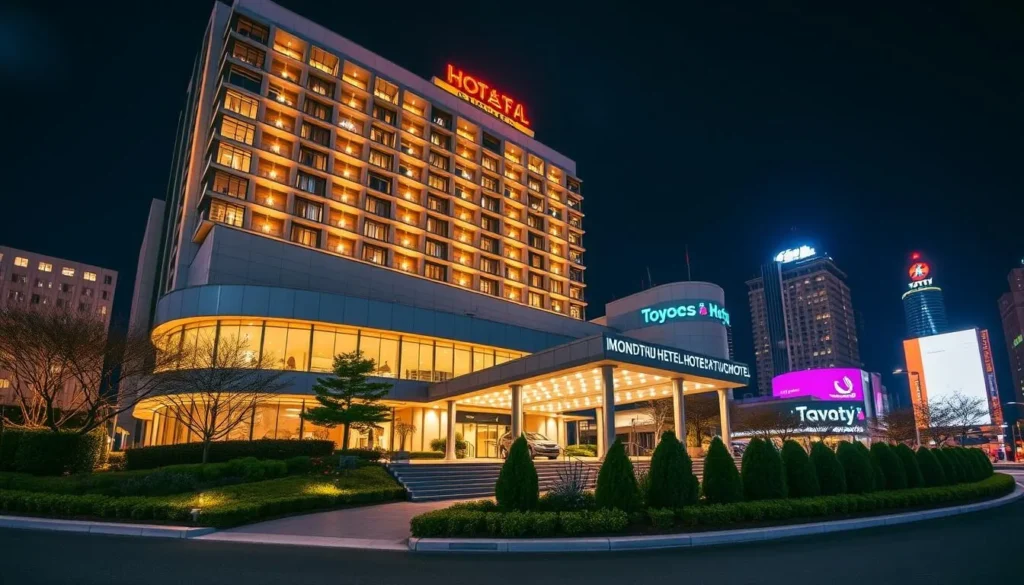
Luxury Accommodations
For those seeking a luxurious stay, Minato-ku offers several high-end hotels that provide top-notch amenities and services. These hotels often feature elegant rooms, fine dining restaurants, and relaxing spas, ensuring a comfortable and indulgent experience.
Some of the top luxury hotels in Minato-ku include:
- The Ritz-Carlton, Tokyo, offering stunning views of the city from its high-rise location.
- The Prince Gallery Tokyo Kioicho, a luxurious hotel with a focus on art and design.
- The Four Seasons Hotel Tokyo at Marunouchi, providing elegant accommodations and exceptional service.
These luxury hotels are perfect for travelers looking to indulge in the best that Minato-ku has to offer.
Mid-Range Hotels
For travelers on a moderate budget, Minato-ku offers a range of mid-range hotels that balance comfort and affordability. These hotels often provide clean, well-appointed rooms, convenient locations, and essential amenities.
Some popular mid-range hotels in the area include:
- Hotel Gajoen Tokyo, a unique hotel featuring Japanese art and culture.
- Nui.Tokyo Central Hostel, offering a mix of dormitory and private rooms.
- Remm Akihabara Hotel, a modern hotel with a convenient location near Tokyo’s electronics district.
These mid-range hotels are ideal for travelers seeking a comfortable stay without breaking the bank.
Budget-Friendly Options
For budget-conscious travelers, Minato-ku has several affordable accommodation options, including budget-friendly hotels and hostels. These establishments offer basic amenities and clean rooms at reasonable prices.
Some budget-friendly options to consider:
- Via Inn Prince Akasaka, offering clean, comfortable rooms at budget-friendly rates.
- APA Hotel & Resort Tokyo Bay Shibaura, a reliable business hotel chain with multiple locations.
- Tokyu Stay Shinbashi, an apartment-style accommodation with in-room washing machines and kitchenettes.
Staying in a budget-friendly hotel in Minato-ku allows you to allocate more of your travel budget to experiences, dining, and shopping while still enjoying a central location.
Getting Around Minato-ku: Transportation Guide
As you plan your trip to Minato-ku, understanding the local transportation options is key to a smooth journey. Minato-ku, being a central and sophisticated district in Tokyo, offers a variety of transportation methods to suit different needs and preferences.
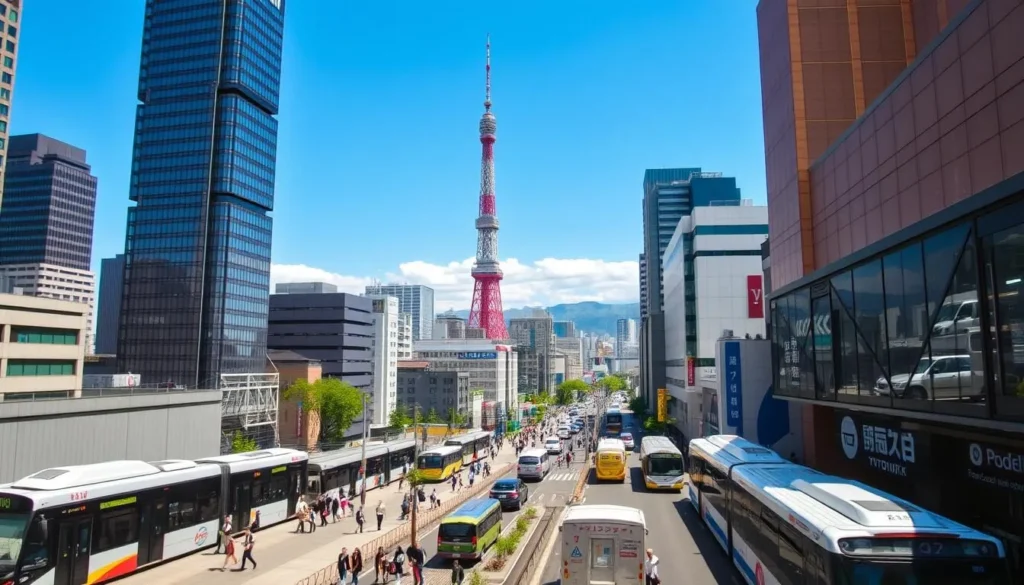
Navigating Tokyo’s Metro System
Tokyo’s metro system is renowned for its efficiency and comprehensiveness, making it an ideal way to explore Minato-ku and the wider city. The district is served by several major subway lines, including the Ginza, Marunouchi, and Hibiya lines, ensuring that you can easily reach most attractions. To navigate the metro system effectively, consider purchasing a prepaid IC card such as a Suica or Pasmo card, which can be used not only on subways but also on buses and some train lines.
When using the metro, be mindful of the peak hours (usually 7:00-9:00 AM and 5:00-7:00 PM on weekdays) when the trains are more crowded. The metro system is generally very safe and reliable, but it’s always a good idea to familiarize yourself with the exit signs and transfer points in advance to avoid confusion.
Walking Routes Between Major Attractions
Walking is another excellent way to explore Minato-ku, especially since many of the district’s major attractions are relatively close to each other. For instance, you can easily walk from Tokyo Tower to Zojoji Temple, enjoying the surrounding gardens and architecture along the way. Similarly, the area around Roppongi Hills is pedestrian-friendly, with well-marked paths and interesting sights to discover.
When walking, be sure to follow the local traffic rules and pedestrian signals. Tokyo is known for its disciplined pedestrians, and adhering to these norms will make your walking experience more enjoyable. Additionally, consider downloading a map or using a GPS-enabled device to help navigate the streets, as some areas can be quite dense and complex.
Taxis and Alternative Transportation
Taxis are readily available throughout Minato-ku and can be a convenient option, especially in the evening or when carrying luggage. Taxis in Tokyo are clean, safe, and plentiful, making them a viable alternative when you’re tired from sightseeing or carrying shopping bags. You’ll find taxi stands outside major stations and attractions, though you can also hail taxis on the street when their red “vacant” light is illuminated.
- Taxis in Tokyo are clean, safe, and plentiful, making them a convenient option when you’re tired from sightseeing or carrying shopping bags.
- You’ll find taxi stands outside major stations and attractions, though you can also hail taxis on the street when their red “vacant” light is illuminated.
- For a unique perspective of Tokyo, consider taking a water bus from Hinode Pier in Minato-ku to other waterfront destinations like Asakusa or Odaiba.
- Rental bicycles are available in some areas of Minato-ku, offering an eco-friendly way to explore the district at your own pace.
- Ride-sharing services like Uber exist in Tokyo but are generally more expensive than regular taxis and offer fewer advantages than in other countries.
By utilizing these transportation options, you can navigate Minato-ku with ease, enjoying all that this vibrant city has to offer. Whether you’re visiting iconic landmarks like Tokyo Tower or exploring the local culture, the right transportation choice can make your visit even more enjoyable, making your place in this city a memorable one.
Minato-ku, Tōkyō, Japan: Best Things to Do – Top Picks
With its rich history, vibrant culture, and breathtaking views, Minato-ku is a must-visit destination in Tokyo. This sophisticated district is home to a diverse range of attractions, from iconic landmarks to serene gardens, ensuring that there’s something for every traveler to enjoy.
![]()
One-Day Itinerary in Minato-ku
To make the most of your day in Minato-ku, start early at Tokyo Tower, where you can enjoy panoramic views of the city from its observation decks. From there, take a short walk to Zojoji Temple, a historic Buddhist temple that offers a serene escape from the bustling city. After exploring the temple grounds, head to Roppongi Hills, where you can enjoy shopping, dining, and entertainment options.
In the afternoon, visit the Mori Art Museum, located within Roppongi Hills, to explore contemporary art exhibitions. If you’re looking for more great views, stop by Tokyo City View, also located in Roppongi Hills, for breathtaking vistas of the city.
Two-Day Exploration Plan
With two days, you can delve deeper into Minato-ku’s attractions. On the first day, follow the one-day itinerary, and on the second day, start with a visit to Hamarikyu Gardens, a tranquil oasis in the heart of the city. Take a leisurely stroll around the gardens, enjoying the seasonal foliage and the historic tea house.
In the afternoon, head to Azabudai Hills, Tokyo’s newest landmark, where you can enjoy shopping, dining, and panoramic views from its observation points. If you’re interested in art, consider visiting the Nezu Museum, which houses an impressive collection of Japanese and East Asian art.
Seasonal Considerations for Your Visit
Minato-ku is a year-round destination, with each season offering unique experiences. Spring is ideal for cherry blossom viewing in Shiba Park and other green spaces, while autumn showcases spectacular foliage in the district’s parks and gardens. Summer brings vibrant festivals and events, and winter offers crisp, clear days with excellent visibility from observation decks, plus spectacular illuminations and holiday decorations.
| Season | Best Time to Visit | Highlights |
|---|---|---|
| Spring | March to May | Cherry blossoms in Shiba Park, mild temperatures |
| Summer | June to August | Vibrant festivals, summer events at Tokyo Midtown and Roppongi Hills |
| Autumn | September to November | Spectacular foliage in parks and gardens, especially in Hamarikyu Gardens |
| Winter | December to February | Crisp, clear days, excellent visibility from observation decks, illuminations, and holiday decorations |
Regardless of when you visit, Minato-ku’s indoor attractions, such as museums, shopping complexes, and observation decks, offer comfortable environments in any weather, making it a great place to explore over multiple days.
Conclusion
As you discover the many facets of Minato-ku, you’ll find that it embodies the perfect blend of old and new Tokyo. This sophisticated district is a treasure trove of experiences, offering something for every kind of traveler. Whether you’re a history buff, an architecture enthusiast, a foodie, or simply someone who appreciates the beauty of a well-designed city, Minato-ku has something special in store for you.
Minato-ku exemplifies Tokyo’s remarkable ability to harmoniously blend ancient traditions with cutting-edge modernity in a single district. You’ve discovered how this ward offers everything from historic temples and traditional gardens to world-class museums and futuristic architecture. The iconic Tower that dominates the skyline is not just a landmark but a symbol of the district’s embrace of innovation and progress.
The district’s diverse attractions cater to all interests, making it a fascinating place to explore. From the serene Hamarikyu Gardens to the bustling streets of Roppongi, each area of Minato-ku offers a unique perspective on Tokyo’s lifestyle and culture. The strategic location of Minato-ku, coupled with its excellent transportation connections, makes it an ideal base for exploring not just the ward itself but the greater Tokyo area.
As you plan your visit, consider the time of year and how it might impact your experience. Minato-ku is a year-round destination, with each season bringing its own charm to the district. Whether you visit for a few hours or several days, Minato-ku leaves a lasting impression as a microcosm of contemporary Japan – respectful of its past while boldly embracing the future. This city within a city is a testament to Tokyo’s ability to evolve while retaining its cultural heritage, making it a compelling place to visit.
In conclusion, Minato-ku is more than just a district in Tokyo; it’s an experience that encapsulates the essence of this vibrant city. With its unique blend of tradition and modernity, Minato-ku stands out as a must-visit destination for anyone traveling to Tokyo.
